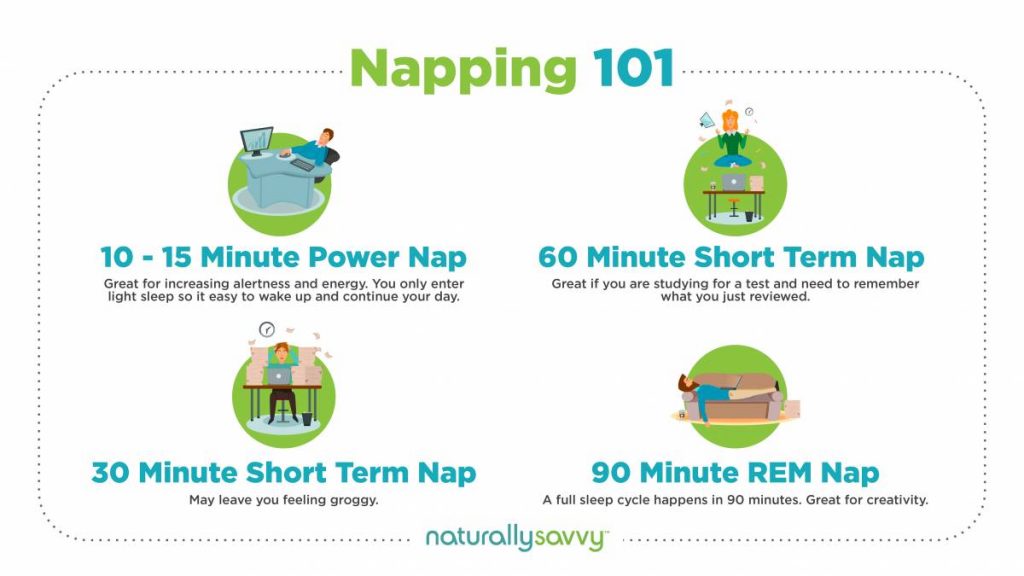
According to a 2009 survey, one-third of American adults manage to do this on any given day of the week. We’re talking about napping. If you are among this percentage, are you taking the best nap you can? Are naps beneficial? If you don’t take naps, should you, would you, and why?
Let’s explore these and other questions about napping.
What is a nap?
A nap is an intentional or unintentional period of sleep for a short period of time, typically taken during the daylight hours. Scientists have done quite a bit of investigation into napping and developed a list of different types or categories of naps based on their function.
Read about 10 signs you’re sleep deprived (and what to do about it)
Types of naps
Not all naps are created equal or provide the same benefits. For example:
- Appetitive: naps you take to enjoy the experience. These naps are relaxing and can result in an improved mood and greater energy
- Essential: When we are sick, we tend to nap more. Naps taken when we are ill are considered essential for recovery.
- Fulfillment: Remember as a child you had nap time? Children need more sleep than adults. Fulfillment naps are typically scheduled but can be spontaneous naps for infants, toddlers, and older children.
- Prophylactic: naps you take when you know you will be losing sleep. For example, if you work the night shift, you may benefit from a nap before and during your shift. A “during work” nap may be possible if you bring an alarm clock and nap during a break.
- Recovery: Did you party into the wee hours of the morning or miss out on sleep because of a sick child? If you take a recovery nap the next day, you might help make up the sleep deficit.
Read about why sleep is important
How long should you nap?
Naps are periods of sleep, which means once you fall asleep, you begin to go through the various stages of sleep. Knowing how long each stage lasts can help explain how long you should nap and what impact each length of nap time can have on you.
There are three stages of non-REM (rapid eye movement) sleep and one of REM. Stage 1 is when your eyes are closed and it’s easy to wake you up. It lasts 5 to 10 minutes. Stage 2 is light sleep and preparation for deep sleep. It lasts for 10 to 25 minutes. During stage 3 your body is in deep sleep. Your body repairs tissues, builds muscle and bone, and enhances your immune system. REM sleep typically begins 90 minutes after you fall asleep. It’s when you dream and when the brain is stimulated to learn.
With that in mind, here are the effects of different nap times:
Power nap 10 to 15 minutes: This nap can boost your energy and alertness. A power nap is ideal to take during your afternoon coffee break.
Short-term 30 minutes: You can expect to feel groggy if you take a 30-minute snooze. The grogginess can last about one hour, a state sometimes referred to as sleep inertia.
Short-term 60 minutes: This nap time is ideal if you need or want to remember what you were reading or studying before taking the nap. Going to school, taking a test, or learning a new language? Then this nap may be for you.
REM 90 minutes: Need a creativity boost? Then it’s dream time and some REM sleep for you.

Pros and cons of napping
Depending on the type and length of nap you take, as well as your age, the time you take your nap, and why you are napping, you can expect to reap the following benefits:
- Feeling of restfulness
- Reduced sleepiness
- Help with forming memories
- Stabilized emotions
- Improved reaction times and alertness among shift workers
- Less likely to be involved in a vehicular accident
On the downside, if you have insomnia, napping can make it even more challenging to fall asleep or stay asleep.
Tips for great napping
Get the most from your nap. Here are a few tips for success.
- Choose your nap. Plan your nap based on what you hope to accomplish. If you need an energy boost, then go for the power nap. If you’re writing a paper or a novel and have hit writer’s block, then a creative-reviving nap may be in order.
- Set an alarm. Use your watch, cell phone, or an alarm clock to ensure you wake up at the desired time. Since the optimal nap time for a restorative nap is 10 to 20 minutes, it’s easy to oversleep without a wake-up call.
- Nap in the middle. That’s the middle of the day, if possible. If you get up at 6 AM and go to bed at 10 PM, the best time for napping is between 2 and 3 PM.
- Be comfortable. To maximize your experience, nap in a space that is cool, quiet, and dark. If this isn’t possible, do the best you can.
- Relax. Practice relaxation techniques to help you fall asleep. Deep breathing, stretching, progressive relaxation, and visualization can help.
Bottom line
Napping can be a great boost for your energy level, creativity, memory, focus, and mood. The wrong nap, however, can make you feel worse. Choose the nap that fits your needs and happy zzz's.










